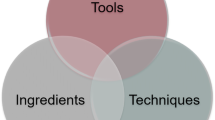Abstract
Instructional design may help make educational research more useful and influential. In this discussion, I argue that instructional design anchor points (IDAPs) are the basis for this kind of research. In short, IDAPs are educational tools or approaches that can be studied to generate design guidelines. The study of IDAPs may become more useful and more influential when it meets at least the following four conditions: (a) a clear description of the IDAP under study; (b) presence of a clear conceptual framework; (c) a deliberate consideration of complexity; and (d) a realistic perspective on improvement and implementation. This two-part special issue of Educational Technology Research and Development, on electronic learning environments, illustrates the possibilities and pitfalls of studying IDAPs.
In this contribution, the four conditions are illustrated by referring to the main articles of the special issue. Indeed, it is argued that electronic environments are the most recent version of an IDAP. The discussion highlights the need for a clear description of the IDAP electronic learning environment, the elaboration of a layered conceptual framework, a more systematic consideration of limitations, and a good balance between realism and voluntarism.
Similar content being viewed by others
References
Birenbaum, M. (2003). New insights into learning and teaching and their implications for assessment. In M. Segers, F. Dochy, & E. Cascallar (Eds.),Optimising new modes of assessment: In search of quality and standards (pp. 13–36). Dordrecht, The Netherlands: Kluwer Academic Publishers.
Burkhardt, H., & Schoenfeld, A. H. (2003). Improving educational research: Toward a more useful, more influential, and better funded enterprise.Educational Researcher, 32(9), 3–14.
Clark, R. E., & Estes, F. (1998). Technology or craft: What are we doing?Educational Technology, 38(5), 5–11.
Dillenbourg, P. (1999). Introduction: What do you mean by ‘collaborative learning’? In P. Dillenbourg (Ed.).Collaborative learning. Cognitive and computational approaches (pp. 1–19). Amsterdam: Pergamon Press.
Elen, J. (1995). Blocks on the road to instructional design prescriptions. Leuven: Leuven University Press.
Gibson, J. J. (1977). The theory of affordances. In R. Shaw & J. Bransford (Eds.),Perceiving, acting, and knowing (pp. 67–82). Hillsdale, NJ: Erlbaum.
Gulikers, Bastiaens, & Kirschner. (2004) [Special issue, part I].Educational Technology Research and Development, 52(3), 67–86.
Jonassen, D. H. (1982).The technology of text. Principles for structuring, designing, and displaying text. Englewood Cliffs, NJ: Educational Technology Publications.
Kirschner. (2004). Introduction to the special issue: [Special issue, part I].Educational Technology Research and Development, 52(3), 39–46.
Kirschner, Strijbos, Kreijns, & Beers. (2004). [Special issue, part I].Educational Technology Research and Development, 52(3), 47–66.
Ledford, B. R., & Sleeman, P. J. (2000).Instructional design: A primer. Greenwich, CT: Information Age Publishing.
Mayer, R. (2001).Multimedia learning. Cambridge: Cambridge University Press.
Norman, D. A. (1999). Affordance, conventions, and design.Interactions, 6(3), 38–43.
Psotka, J., Massey, L. D., & Mutter, S. A., (1988) (Eds.).Intelligent tutoring systems: Lessons learned. Hillsdale, NJ: Erlbaum.
Reigeluth, C. M. (1983). Instructional design: What is it and why is it? In C. M. Reigeluth (Ed.).Instructional design theories and models: Vol. 1 (pp. 3–36). Hillsdale, NJ: Erlbaum.
Reigeluth, C. M. (1999). What is instructional design theory and how is it changing? In C. M. Reigeluth (Ed.).Instructional design theories and models: Vol. II, A new paradigm of instruction theory (pp. 5–30). Mahwah, NJ: Erlbaum.
Skinner, B. F. (1968).The technology of teaching. New York: Appleton-Century-Crofts.
Spiro, R. J., Feltovich, P. J., Jacobson, M. J., & Coulson, R. L. (1991). Cognitive flexibility, constructivism, and hypertext: Random access instructions for advanced knowledge acquisition in ill-structured domains.Educational Technology, 31(5), 24–33.
Van Dijk, T. A., & Kintsch, W. (1983).Strategies of discourse comprehension. New York: Academic Press.
Winn, W. (2003), Beyond constructivism: A return to science-based research and practice in educational technology.Educational Technology, 43(6), 5–14.
Author information
Authors and Affiliations
Corresponding author
Rights and permissions
About this article
Cite this article
Elen, J. Turning electronic learning environments into useful and influential ‘instructional design Anchor points'. ETR&D 52, 67–73 (2004). https://doi.org/10.1007/BF02504719
Issue Date:
DOI: https://doi.org/10.1007/BF02504719




